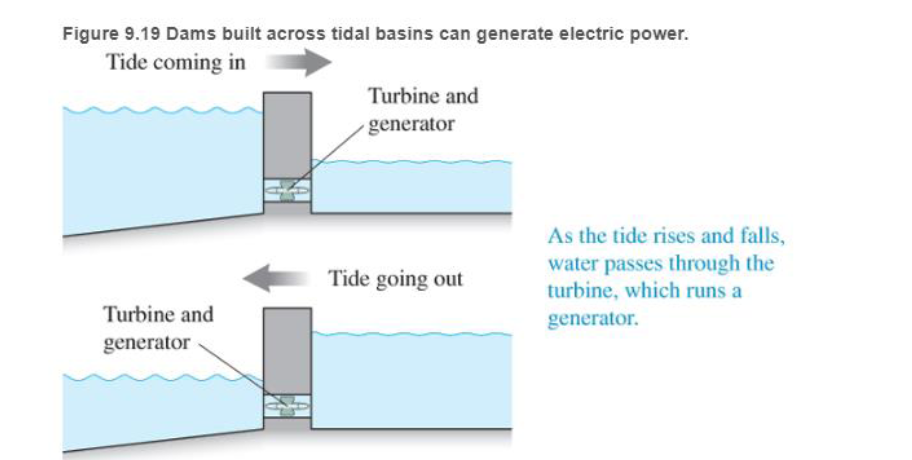
Concept explainers
Tidal energy Tides are now used so gene-ate electric power in two ways. In the first, huge dams can be built. across the mouth of a river where it exits to the ocean. As the ocean tide moves in and out of this tidal bas in or estuary, the water flows through tunnels in the dam (see Figure 9.19). This flowing water turns turbines in the tunnels that run electric generators. Unfortunately, this technique works best with large increases in tides—a 5-m difference between high and low tide Such differences are found at only a small number of places Currently, France is the only country that successfully uses this power source A tidal basin plant in France, the Rance. Tidal Power Station. makes 240 megawatts of power—enough energy to power 240,000 homes. Damming tidal basins can have negative environmental effects because of reduced tidal flow and silt buildup. Another disadvantage is that they can only generate electricity when the tide is flowing in or out, for about 10 hours each day.

A second method for collecting energy from the tidal flow (as well as all water flow) is to place turbines directly in the water—like windmills in moving water instead of in moving air. These water turbines have the advantages that they are much cheaper to build, they do not have the environmental problems of a tidal basin, and there are many more suitable sites for such water flow energy farms. Also the energy density of flowing water is about 800 times the energy density of dry air flow. Verdant Power is developing turbine prototypes in the East River near New York City and in the Saint Lawrence Seaway in Canada, and they are looking at other sites in the Puget Sound and all over the world. The worldwide potential tor hydroelectric power is about
Which of the following is a correct statement about water turbines? a Water turbines can operate only in moving tidal water.
b. Water turbines can produce only a small amount of electricity.
c. Water turbines have not had a proof of concept.
d. Water turbines cause significant ocean warming.
e. None of the above are correct statements.
Want to see the full answer?
Check out a sample textbook solution
Chapter 9 Solutions
EBK COLLEGE PHYSICS
Additional Science Textbook Solutions
Genetic Analysis: An Integrated Approach (3rd Edition)
Anatomy & Physiology (6th Edition)
Campbell Biology: Concepts & Connections (9th Edition)
Chemistry (7th Edition)
Applications and Investigations in Earth Science (9th Edition)
Chemistry: Structure and Properties (2nd Edition)
- 20. Two small conducting spheres are placed on top of insulating pads. The 3.7 × 10-10 C sphere is fixed whie the 3.0 × 107 C sphere, initially at rest, is free to move. The mass of each sphere is 0.09 kg. If the spheres are initially 0.10 m apart, how fast will the sphere be moving when they are 1.5 m apart?arrow_forwardpls help on allarrow_forwardpls help on thesearrow_forward
- pls help on all asked questions kindlyarrow_forwardpls help on all asked questions kindlyarrow_forward19. Mount Everest, Earth's highest mountain above sea level, has a peak of 8849 m above sea level. Assume that sea level defines the height of Earth's surface. (re = 6.38 × 106 m, ME = 5.98 × 1024 kg, G = 6.67 × 10 -11 Nm²/kg²) a. Calculate the strength of Earth's gravitational field at a point at the peak of Mount Everest. b. What is the ratio of the strength of Earth's gravitational field at a point 644416m below the surface of the Earth to a point at the top of Mount Everest? C. A tourist watching the sunrise on top of Mount Everest observes a satellite orbiting Earth at an altitude 3580 km above his position. Determine the speed of the satellite.arrow_forward
- pls help on allarrow_forwardpls help on allarrow_forward6. As the distance between two charges decreases, the magnitude of the electric potential energy of the two-charge system: a) Always increases b) Always decreases c) Increases if the charges have the same sign, decreases if they have the opposite signs d) Increases if the charges have the opposite sign, decreases if they have the same sign 7. To analyze the motion of an elastic collision between two charged particles we use conservation of & a) Energy, Velocity b) Momentum, Force c) Mass, Momentum d) Energy, Momentum e) Kinetic Energy, Potential Energyarrow_forward
 Physics for Scientists and Engineers: Foundations...PhysicsISBN:9781133939146Author:Katz, Debora M.Publisher:Cengage Learning
Physics for Scientists and Engineers: Foundations...PhysicsISBN:9781133939146Author:Katz, Debora M.Publisher:Cengage Learning College PhysicsPhysicsISBN:9781285737027Author:Raymond A. Serway, Chris VuillePublisher:Cengage Learning
College PhysicsPhysicsISBN:9781285737027Author:Raymond A. Serway, Chris VuillePublisher:Cengage Learning
 Principles of Physics: A Calculus-Based TextPhysicsISBN:9781133104261Author:Raymond A. Serway, John W. JewettPublisher:Cengage Learning
Principles of Physics: A Calculus-Based TextPhysicsISBN:9781133104261Author:Raymond A. Serway, John W. JewettPublisher:Cengage Learning Physics for Scientists and Engineers with Modern ...PhysicsISBN:9781337553292Author:Raymond A. Serway, John W. JewettPublisher:Cengage Learning
Physics for Scientists and Engineers with Modern ...PhysicsISBN:9781337553292Author:Raymond A. Serway, John W. JewettPublisher:Cengage Learning Physics for Scientists and EngineersPhysicsISBN:9781337553278Author:Raymond A. Serway, John W. JewettPublisher:Cengage Learning
Physics for Scientists and EngineersPhysicsISBN:9781337553278Author:Raymond A. Serway, John W. JewettPublisher:Cengage Learning





